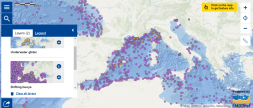Ocean observation and monitoring are crucial for our society. The marine data collected through oceanographic instruments and other data collection activities help us, among other things, to improve our understanding of the state of the seas and its role in climate mitigation.
At the EOOS Conference 2018 in Brussels, an event where 300 participants discussed the future of ocean observing, monitoring and data collection efforts in Europe, Commissioner Vella stated the essential role of marine data and observation: “Sound ocean data is indispensable if we want to tackle major global issues such as climate change, marine litter, illegal fishing or marine protection. It is also a bare necessity if we want to develop the blue economy and create sustainable economic growth in the EU”.
Our “Map of the week” highlights the use of two types of oceanographic instruments that automatically collect ocean data and monitor the seas. The first one, underwater gliders, are platforms for sensors which measure such as temperature, conductivity (to calculate salinity), currents, chlorophyll fluorescence, optical backscatter, bottom depth, and (occasionally) acoustic backscatter. They travel at various water depths and navigate with the help of periodic surface GPS fixes, pressure sensors, tilt sensors, and magnetic compasses providing data on temporal and spatial scale.
Free-drifting buoys, on the other hand, move depending on the water currents. Such buoys host sensors measuringstandard oceanographic parameters (e.g. temperature, salinity, currents) and, in more and more cases, other parameters (e.g. turbidity, oxygen and chlorophyll fluorescence). As an example, wave buoys are used to measure the movement of the water surface as a wave train. The wave train is analysed to determine statistics like the significant wave height and period, and wave direction.
If you are interested in European ocean observing and monitoring, we invite you to watch the summary video of the EOOS Conference 2018. It shows how society can benefit from a better coordinated European ocean observing capacity and how the community is calling on nations and European institutions to engage more in more a Call to action.
Data displayed in this map were provided by EMODnet Physics
The Map of the week was initially published on the EMODnet website

